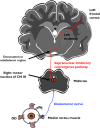Medial strabismus (esotropia) at rest associated with contralateral paramedian thalamic ischemic infarction in 2 dogs
- PMID: 38205674
- PMCID: PMC10937505
- DOI: 10.1111/jvim.16986
Medial strabismus (esotropia) at rest associated with contralateral paramedian thalamic ischemic infarction in 2 dogs
Abstract
Pseudoabducens paralysis resulting in resting medial strabismus (esotropia) is a rare consequence of a contralateral paramedian thalamic ischemic infarction in people. To date, esotropia has been reported in dogs in association with ipsilateral abducens neuropathy or extraocular myopathy, but not secondary to thalamic lesions. A 7-year-old male neutered Border Collie and a 12-year-old female neutered cross-breed dog were presented with peracute nonprogressive vestibular ataxia. Neurological examination identified right esotropia, nonambulatory tetraparesis, right head tilt, vestibular ataxia and nystagmus. Lesions in both dogs were localized to the vestibular system with thalamic involvement. Magnetic resonance imaging of the brain identified a left paramedian thalamic lacunar ischemic infarct in both dogs. Interruption of descending inhibitory pathways that decussate in the subthalamic region and innervate the contralateral motor nucleus of the oculomotor nerve leads to hypertonicity of the medial rectus. These cases indicate that esotropia is a rare but highly localizing sign in dogs with contralateral thalamic infarcts.
Keywords: cerebrovascular accident; motor nucleus of oculomotor nerve; paramedian thalamus; pseudoabducens palsy; thalamic esotropia.
© 2024 The Authors. Journal of Veterinary Internal Medicine published by Wiley Periodicals LLC on behalf of American College of Veterinary Internal Medicine.
Conflict of interest statement
Authors declare no conflict of interest.
Figures




Similar articles
-
Isolated pseudoabducens palsy in acute thalamic stroke.Clin Imaging. 2017 May-Jun;43:28-31. doi: 10.1016/j.clinimag.2017.01.013. Epub 2017 Feb 1. Clin Imaging. 2017. PMID: 28167284
-
Surgical management of unilateral restrictive strabismus in an 8-month-old dog.N Z Vet J. 2024 Sep;72(5):300-306. doi: 10.1080/00480169.2024.2361619. Epub 2024 Jun 17. N Z Vet J. 2024. PMID: 38885962
-
Clinical and topographic magnetic resonance characteristics of suspected brain infarction in 40 dogs.J Vet Intern Med. 2006 Mar-Apr;20(2):311-21. doi: 10.1892/0891-6640(2006)20[311:catmrc]2.0.co;2. J Vet Intern Med. 2006. PMID: 16594588
-
Abnormal vergence with upper brainstem infarcts: pseudoabducens palsy.Neurology. 2000 Aug 8;55(3):352-8. doi: 10.1212/wnl.55.3.352. Neurology. 2000. PMID: 10932266 Review.
-
Movement disorders following lesions of the thalamus or subthalamic region.Mov Disord. 1994 Sep;9(5):493-507. doi: 10.1002/mds.870090502. Mov Disord. 1994. PMID: 7990845 Review.
References
-
- Caplan LR. “Top of the basilar” syndrome. Neurology. 1980;30:72‐79. - PubMed
-
- Pullicino P, Lincoff N, Truax BT. Abnormal vergence with upper brainstem infarcts: pseudoabducens palsy. Neurology. 2000;55:352‐358. - PubMed
-
- Ghasemi M, Riaz N, Bjornsdottir A, Paydarfar D. Isolated pseudoabducens palsy in acute thalamic stroke. Clin Imaging. 2017;43:28‐31. - PubMed
-
- Garosi L, McConnell JF, Platt SR, et al. Clinical and topographic magnetic resonance characteristics of suspected brain infarction in 40 dogs. J Vet Intern Med. 2006;20:311‐321. - PubMed
-
- Gonçalves R, Carrera I, Garosi L, Smith PM, Fraser McConnell J, Penderis J. Clinical and topographic magnetic resonance imaging characteristics of suspected thalamic infarcts in 16 dogs. Vet J. 2016;188:39‐43. - PubMed
Publication types
MeSH terms
LinkOut - more resources
Full Text Sources

